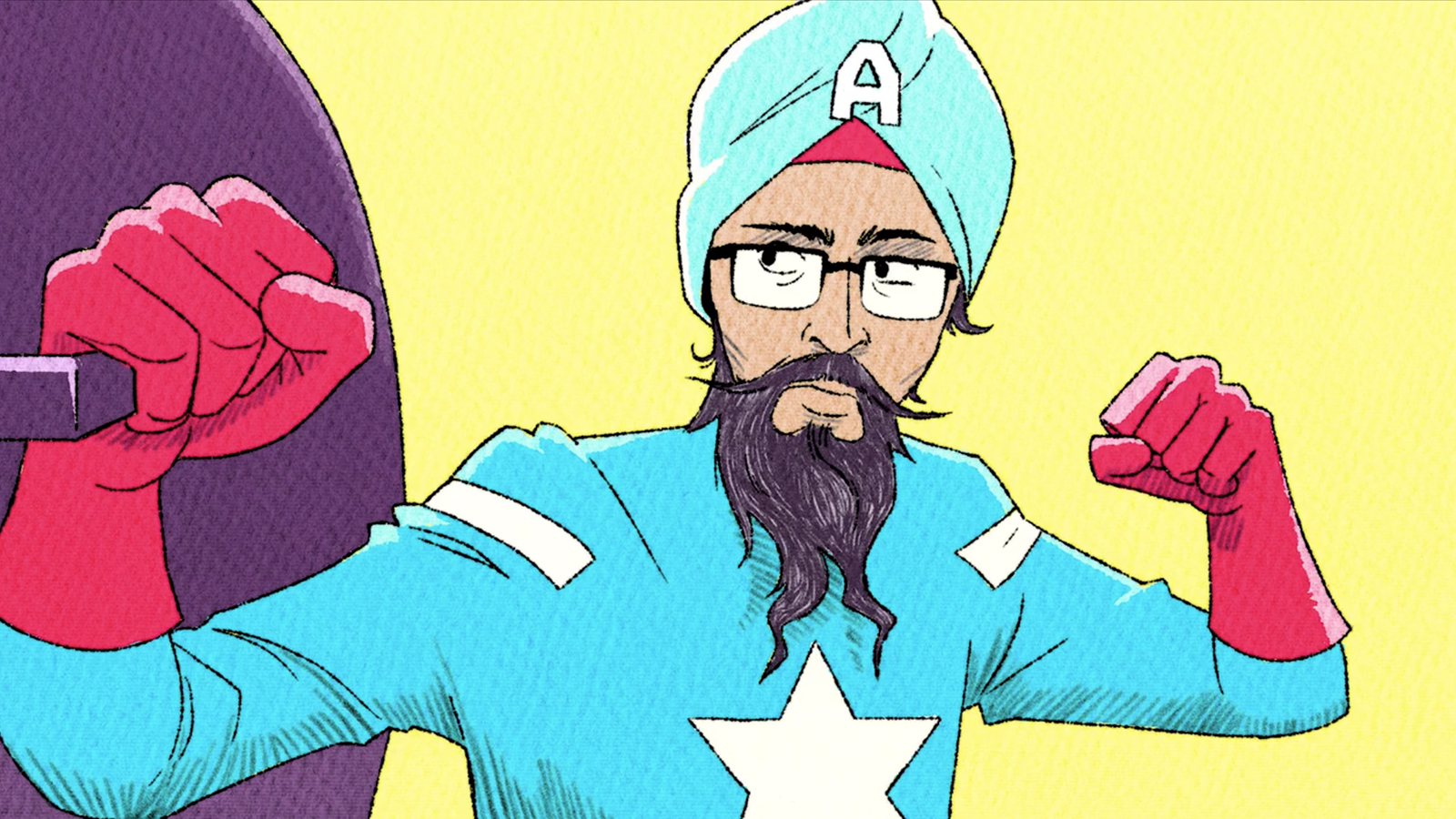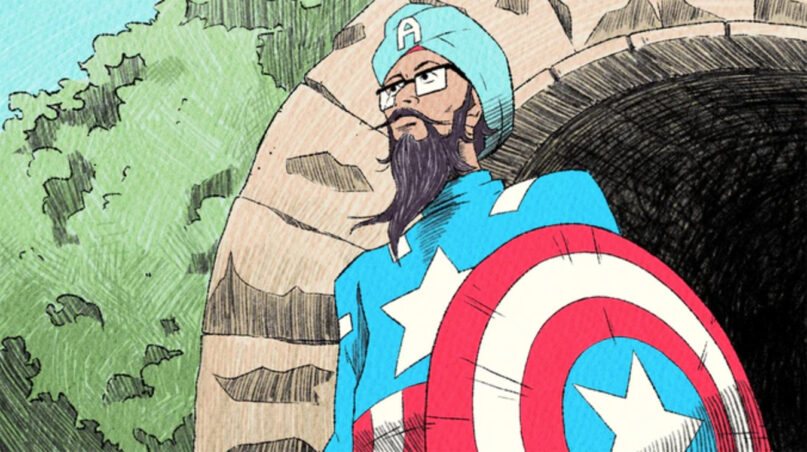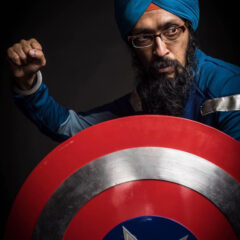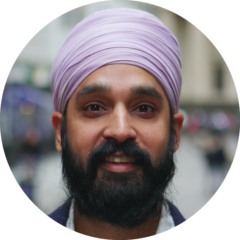(RNS) — Once the idea for Sikh Captain America — a turbaned, bearded version of the Marvel comic hero — was born, it took more than a year for him to appear on the streets of his native New York City.
The creation of Vishavjit Singh, a writer and illustrator in Harlem, and the photographer Fiona Aboud, who was working on a photo project, “Sikhs: An American Portrait,” the character is a social experiment about what it means to be American, and to be Sikh in America. Now, it is also a short animated film by Singh and Ryan Westra that recently premiered at the Tribeca Film Festival.
The film tells the true story of Singh, 52, who, besides inventing Sikhtoons.com in the face of anti-Sikh bigotry after 9/11, is a performance artist and diversity speaker. After a lifetime of facing prejudice, self-doubt and violence, his animated self, as in life, finally finds acceptance in a superhero costume. He first drew Captain America in a turban and beard in 2011, but it took almost a year after Aboud discovered the character to convince Singh to step out as Sikh Captain America on the streets, where his mission is to tackle bias and intolerance, powered by his humor, turban, beard and storytelling prowess.
I had the opportunity to speak with Singh and Westra to discuss the what, why and how of “American Sikh.” This interview has been adapted for clarity and concision.
How did this film come together?
RW: In 2014, as my very last student project in film school, I happened to be assigned to do a live action documentary about Vishavjit’s work as Sikh Captain America. While shooting that project (“Red, White, and Beard”), I was so impressed by Vishavjit’s ability to inspire people to open up about their stereotypes and biases in a positive way. Yet as we wrapped the shoot, I watched a stranger on the street call Vishavjit “Osama bin Laden,” moments after changing out of his superhero costume.
It was a shocking juxtaposition to witness, and it made Vishavjit’s work even more impactful to me. Ever since then, I had been interested in working with Vishavjit again on a more in-depth and ambitious project. In 2019, I reached out with the idea of doing an animated short about his life and, more broadly, the struggles that the Sikh community has gone through.
What do you hope the film will accomplish?
RW: In a recent interview, our incredible executive producer, Vikas Khanna, had a beautiful answer to this question. He said, “I believe that the answer to hate cannot be hate.” With the difficult times we are facing right now around the world, I think now, more than ever, is a perfect time for us to gain greater understanding, empathy and compassion for those around us.
VS: I’ve spent years traveling around the nation visiting schools, companies and government agencies to share my story and create a space for conversations about identity, bias, vulnerability and transformative power of art. I hope in amplifying this message via an animated film, we can encourage others to do the same with their story.
I hope this film opens doors for the most underrepresented and misrepresented stories to be shared across American media, cultural and entertainment landscape.
RW: Unfortunately, especially since 9/11, turbans and beards have been villainized and portrayed as un-American in the media. Sikh Captain America challenges those stereotypes in a lighthearted, creative and familiar way. Our hope is that this image sticks with people, and they are able to walk away with a greater empathy for all Americans who, as Vishavjit says, “look a little different.”
What’s been most gratifying so far now that audiences have seen the movie?
VS: Hearing feedback from people from varying backgrounds about connections they find with my story.
RW: It’s extremely exciting to be working with Vishavjit on such a historic project. Never has an American Sikh story reached this level of prominence. With so little representation in the media, it’s exciting that we have the privilege of introducing Vishavjit’s beautiful religion and work to so many for the first time.
How does this film depict Sikh characters differently than other media?
VS: Much of the Sikh media I’ve seen has been created by Sikhs for Sikhs. This film is meant for people who maybe have had little to no experience with Sikhs. It’s created with a national audience in mind and tells a story that is relatable to many Americans, not just Sikhs.

A still from “American Sikh” depicting Vishavjit Singh as his Captain America persona. Image via Kickstarter
What were some of the biggest challenges to pulling this story together?
VS: With animation being extremely expensive, we had a lot of back and forth narrowing down the few key chapters of my life to tell the most compelling and concise story. There were 30 different cuts of the film that we user-tested on Ryan’s friends and family who knew nothing about me or Sikhism at all. This helped us pick the most impactful moments. But there are a few poignant moments and experiences that did not make it into the final version of the film that I typically include in my life story.
Did you ever doubt that animation was the right medium?
VS: We knew there are two major tragedies that are part of this story — the 1984 genocidal massacre of Sikhs in India, which I survived, and the post-9/11 hate/bias crime wave, which targeted many Sikhs, including me. One of the main reasons we chose animation was it allowed us to showcase these tragedies without overwhelming the viewer.
RW: We didn’t want the tone to focus too much on tragedy, but rather leave the audience feeling inspired and encouraged at the end.
Where do you go from here?
VS: The “American Sikh” has had an amazing journey on the film festival circuit. We always wanted this film to be accessible to American and global audiences. Ryan and I are also writing pitches for full-length films and series. We would love to tell a more comprehensive American story with a Sikh lead character.
RW: We are interested in working together again on a longer and more ambitious project featuring a Sikh lead character. We want to make Sikh characters a part of the bigger cultural landscape we see in all media — not just exclusively Sikh stories.







